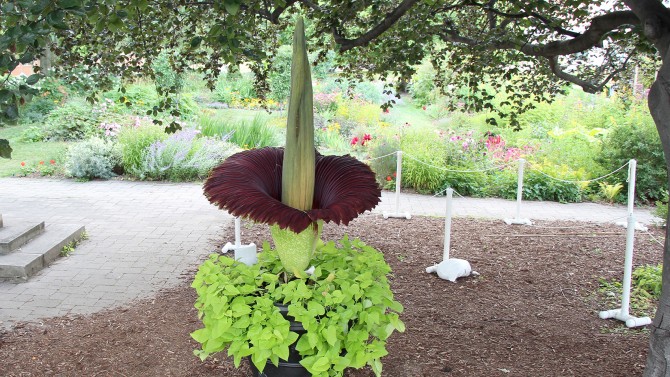Big stink: Titan arum blooms outside for first time
By Craig Cramer
Summer breezes wafting through Cornell's Minns Garden carried the aromas of fresh grass, notes of floral and, for a few days in August, something akin to rotting meat.
Yet the chance to experience that repugnant odor drew thousands of visitors to the garden near the Plant Science Building. The reason: Carolus, one of the College of Agriculture and Life Sciences' Titan arums (Amorphophallus titanum), as the giant, smelly tropical plant also known as a corpse flower bloomed outdoors for the first time ever in a region outside of the tropics.
Carolus started its dramatic show Aug. 7, unleashing its mighty rotten-meat stench that, in the sweltering forests of Sumatra, Indonesia, attracts flies, carrion beetles and other pollinators looking for a snack and a place to lay eggs.
Coaxing the plant to bloom outside in the cool of an Ithaca summer takes a lot of nerve and a little luck, said Paul Cooper, the greenhouse grower for the Cornell University Agricultural Experiment Station (CUAES), who cares for Cornell's two flowering-sized Titan arums. The species produces the largest unbranched inflorescence in the plant world.
"The plant had perfect timing," said Cooper. "When it broke dormancy in June, we realized this might be our only chance to try for an outdoor flowering."
Dubbed Carolus during its first flowering indoors in 2015, Cooper relocated the plant's 100-pound underground corm June 14 to a pot in Minns Garden, adjacent to the Liberty Hyde Bailey Conservatory, where the plant would normally bloom.
Despite chilly nights in the 40s and days when the temperature didn't top 70 degrees, Carolus grew 75 inches tall - within an inch of its height when it last flowered.
"It might have been our best bloom yet," said Cooper, who was prepared for the eventuality that Carolus would open weakly or not at all due to the cold temperatures. "The plant really came through. To the best of our knowledge, this is the first time a Titan arum has ever flowered outside in a place this cold."
Crowds surged to the garden to see - and smell - the rare plant in the outdoor setting.
"It was less a museum piece and more like a plant in its natural habitat," said Magdalen Lindeberg, assistant director of the School of Integrative Plant Science (SIPS). "Viewing it outside dancing in the breeze with the flies buzzing around made it a totally different experience."
Cooper deployed sticky traps to learn more about the pollinators that visited during Carolus's brief bloom.
Now that the bloom is done, Carolus will move back inside for the winter, where it is expected to sprout a single leaf that could reach 12 feet in height. The leaf will use photosynthesis to recharge its underground corm for the next flowering.
Wee Stinky, Carolus' sibling that last flowered in October 2016, is in full leaf in the Liberty Hyde Bailey Conservatory on Tower Road. The two plants have been flowering on staggered cycles of roughly every two years since 2012.
Cornell's Titan arums and other plants in the conservatory are one of several plant collections that make up the Liberty Hyde Bailey Hortorium in the Plant Biology Section of SIPS. The conservatory and its plants are maintained by CUAES. The conservatory is open most weekdays from 10 a.m.to 3 p.m.
Craig Cramer is a communications specialist in the School of Integrative Plant Science.
Media Contact
Get Cornell news delivered right to your inbox.
Subscribe